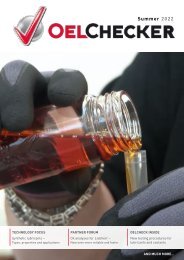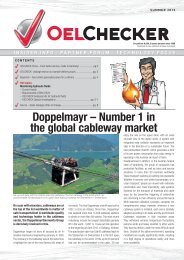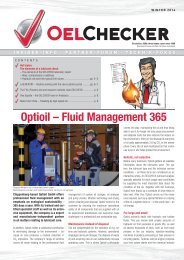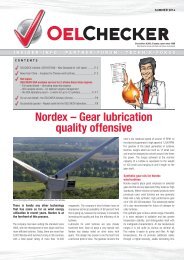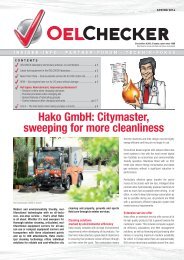OELCHECKER - Spring 2012
> Putzmeister - offering quality worldwide > Analysis kits and gas-tight sample bottles for refrigeration compressor oils > More playtime fun - thanks to OELCHECK! > 2012 customer survey results > The viscosity robot - the new OELCHECK laboratory assistant > Underground maintenance - K+S KALI GmbH workshops > Electrostatic discharges in hydraulic oils and lubricants > Question time: Could lengthy storage times have an influence on your oil samples? > and much more...
> Putzmeister - offering quality worldwide
> Analysis kits and gas-tight sample bottles for refrigeration compressor oils
> More playtime fun - thanks to OELCHECK!
> 2012 customer survey results
> The viscosity robot - the new OELCHECK laboratory assistant
> Underground maintenance - K+S KALI GmbH workshops
> Electrostatic discharges in hydraulic oils and lubricants
> Question time: Could lengthy storage times have an influence on your oil samples?
> and much more...
- No tags were found...
Create successful ePaper yourself
Turn your PDF publications into a flip-book with our unique Google optimized e-Paper software.
OELCHECK TECHNOLOGY FOCUS<br />
Furthermore, at a constant temperature, conductivity<br />
still changes during operation due to additive<br />
reactions, wear metals, reactions with metal<br />
surfaces, water and the formation of ageing and<br />
oxidation products.<br />
Optimisation approaches for the prevention of electrostatic problems<br />
• Installation of special stat-free filters instead of conventional filter cartridges. Such filters can<br />
discharge the charge or even prevent it from occurring.<br />
• Using an oil with a different make-up and poorer conductivity value can have a remedial effect.<br />
• Choose or amend the selection of material combinations in the system so that, despite electrostatic<br />
charge, the formation of microsparks is prevented.<br />
• Optimise flow diameter, tank hold times or tank volumes. As a result, the charge potential can<br />
also be minimised.<br />
Conductivity in pS/m<br />
200<br />
Discharges (ESD) and possible<br />
180<br />
160<br />
140<br />
120<br />
100<br />
80<br />
60<br />
40<br />
20<br />
0<br />
20 25 30 35 40<br />
Temperature in °C<br />
Conductivity of a zinc-free hydraulic oil during temperature<br />
change<br />
The electrostatic charge of oils<br />
Although monitoring conductivity has so far been<br />
unable to achieve any great success in the area of<br />
sensor technology, the parameter is gaining significance<br />
with regard to electrostatic charges and<br />
discharges in lubricant and hydraulic systems.<br />
In oil circulating systems, in general, there can<br />
be electrostatic charges if there is friction in the<br />
flow between the oil and the surfaces surrounding<br />
it. The strength of the static charge depends on<br />
many different and partly interconnected factors.<br />
The energy density, which builds up in the system<br />
and then leads to subsequent discharges, depends<br />
on the oil‘s conductivity and the volume flow. The<br />
more oil flows that through a circulation pipe per<br />
cm² cross-sectional area and the lower the oil‘s<br />
conductivity, the greater the potential for an electrostatic<br />
charge.<br />
Oil can be especially electrostatically charged if:<br />
• The oil is formulated with a base oil from<br />
Group II or III;<br />
• The oil contains no polarising, e.g. zinc-containing,<br />
additives;<br />
• The conductivity of the new or old oil is less than<br />
400 pS/m;<br />
• The oil is fed into pipes which are too small;<br />
• The oil is moved with too high a flow velocity;<br />
• The oil produces friction in poorly designed filter<br />
elements;<br />
• Pipes and hoses are not earthed;<br />
• The oil level has become too low;<br />
• The oil contains high proportions of undissolved<br />
air (air bubbles).<br />
consequences<br />
If the level of electric charge in the system becomes<br />
too great, there will be electrostatic discharge<br />
(ESD). In such cases, micosparks occur<br />
or sparking. Often you can also hear a crackling<br />
or clicking sound near the filter or in the tank. In<br />
the case of high charges, this discharge could be<br />
repeated several times, in quick succession. Locations<br />
at which the discharge primarily occurs are, in<br />
particular, areas with vastly different material combinations.<br />
Modern filters with a high proportion of<br />
plastic are often affected. The microsparks caused<br />
by the static charge lead to temperatures of some<br />
1,000°C. In the case of even slightly flammable<br />
liquids, this can be extremely dangerous. Also, if<br />
hydrocarbon vapours have formed in the tank ventilation<br />
area, a system could spontaneously combust.<br />
However, if the discharge sparks occur within<br />
the circulation system of turbine or hydraulic oils,<br />
they are normally smothered very quickly by the oil.<br />
Nevertheless, these mini explosions can can burn<br />
holes in the filters or even seriously impair the oil<br />
due to the increased build-up of oil sludge.<br />
Turbine and hydraulic oils are<br />
particularly affected<br />
Electrostatic charges and discharges have been<br />
occurring more often in recent years in systems<br />
with turbine and hydraulic oils. Several developments<br />
are responsible for this.<br />
• Modern hydraulic fluids and turbine oils have<br />
become increasingly less conductive because<br />
of the global trend to use modern base oils and<br />
additives. Turbine oils used to be based on relatively<br />
conductive, lightly refined base oils from<br />
Group I. Since then, in particular for gas turbine<br />
oils, more oxidation-resistant, better refined<br />
base oils from Group II or even partly synthetic<br />
base oils from Group III are being used. Such<br />
oils are considerably less conductive. In addition,<br />
turbine oils normally contain hardly any metalorganic<br />
additives. As such, that should prevent the<br />
formation of unwanted deposits (varnish).<br />
• Since new systems enjoy a more compact design,<br />
the tank capacity is considerably smaller<br />
and the displaced volume is proportionally larger.<br />
• At the same time, requirements for oil purity are<br />
increasing. This, in turn, leads to a higher filtration<br />
rate.<br />
• The intensity of the filtration and the electrostatic<br />
charge properties of the oil (resulting from the<br />
filtration) increase.<br />
• Due to the low conductivity of these oils, often far<br />
below 1,000 pS/m, in unfavourable conditions,<br />
the tendency for electrostatic charging increases.<br />
Measure conductivity and prevent<br />
damage<br />
In order to be able to prevent any damage from<br />
electrostatic discharges, it is not only the tivity of fresh oils that needs to be known. For old lu-<br />
conducbricants,<br />
in the case of up quantities of over 1,000<br />
litres, the parameter is also<br />
fillparticularly<br />
important if<br />
nothing is known about the<br />
used oil or a burning smell or<br />
soot particles are noticeable.<br />
Therefore, OELCHECK is now<br />
offering conductivity measurements<br />
at different peratures as an additional<br />
test. The process has been<br />
tested over several years<br />
tem-<br />
and is conducted in line with<br />
ASTM D2624. Originally it<br />
was developed for inspecting<br />
aeroplane kerosene in order to avoid accidents due<br />
to charging in jet fuel.<br />
The oil‘s conductivity value is measured in pS/m.<br />
If conductivity at 20°C is more than 400 pS/m,<br />
there is hardly any risk of any damage to the oil<br />
or the system from electrostatic charges. However,<br />
if the value is lower, there is a very real possibility<br />
that the phenomenon could occur. If an oil with an<br />
increased ESD risk is being used, earthing the entire<br />
system is not a credible countermeasure. The<br />
voltage inside the system cannot be discharged<br />
through an earth wire. However, there are several<br />
other optimisation approaches for active prevention.








